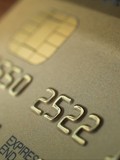
From a site that’s filled with fun and practical information about money (Blueprint For Financial Prosperity: Earn More, Save More, Live More, Enjoy More), check out these little-known facts about credit cards.
I can’t believe there are so many fun & interesting tidbits on this list!…
My favorites:
 The first credit card that could be used at multiple locations was offered by The Diner’s Club in 1950. Bet you didn’t know that Diners Club issued that first card to only 200 customers and it could only be used at 27 restaurants in New York City!
The first credit card that could be used at multiple locations was offered by The Diner’s Club in 1950. Bet you didn’t know that Diners Club issued that first card to only 200 customers and it could only be used at 27 restaurants in New York City!
 Visa was originally called BankAmericard, a card offered by Bank of America in 1958 in California. By 1970, they had created an association, called the National BankAmericard, Inc., of all the US banks that issued the BankAmericard. It wasn’t renamed to Visa until 1976.
Visa was originally called BankAmericard, a card offered by Bank of America in 1958 in California. By 1970, they had created an association, called the National BankAmericard, Inc., of all the US banks that issued the BankAmericard. It wasn’t renamed to Visa until 1976.
 In 1984, MasterCard was the first to use a hologram on its cards to deter fraud.
In 1984, MasterCard was the first to use a hologram on its cards to deter fraud.
 You can lower your interest rate with a phone call. Credit card companies are like cell phone and cable companies, they’re afraid you’ll leave and join with one of their competitors. Use this to your advantage by comparing offers from other credit cards and bringing this information to your credit company.
You can lower your interest rate with a phone call. Credit card companies are like cell phone and cable companies, they’re afraid you’ll leave and join with one of their competitors. Use this to your advantage by comparing offers from other credit cards and bringing this information to your credit company.
Here’s how to lower your credit card rate over the phone.
 If there are unauthorized charges on your card, you’re on the hook for $50 each, maximum (unless your agreement says you are responsible for less, you cannot be responsible for more). If you report your card missing and an unauthorized charge appears after you’ve reported it, you are liable for $0.
If there are unauthorized charges on your card, you’re on the hook for $50 each, maximum (unless your agreement says you are responsible for less, you cannot be responsible for more). If you report your card missing and an unauthorized charge appears after you’ve reported it, you are liable for $0.
 The expiration date on the card is “fake.” You can still use the card after its expiration date because the card number on your replacement will be the same. The reason why cards do expire varies from company to company but mostly it’s because the credit cards take a lot of abuse and just need replacing (they estimate the magnetic strip is good for only about 3 or 4 years of swiping).
The expiration date on the card is “fake.” You can still use the card after its expiration date because the card number on your replacement will be the same. The reason why cards do expire varies from company to company but mostly it’s because the credit cards take a lot of abuse and just need replacing (they estimate the magnetic strip is good for only about 3 or 4 years of swiping).
 Credit card numbers conform to the Luhn algorithm, which is just a simple checksum test on the number. What you do is start from the right and double each second digit (1111 becomes 2121), then add them all together, and you should end with a number evenly divisible by 10. If it doesn’t, it’s not a valid credit card number.
Credit card numbers conform to the Luhn algorithm, which is just a simple checksum test on the number. What you do is start from the right and double each second digit (1111 becomes 2121), then add them all together, and you should end with a number evenly divisible by 10. If it doesn’t, it’s not a valid credit card number.
 When you use a credit card at a gas pump, the pump authorizes the purchase for something in the neighborhood of $50 first. So if you have less than $50 left on your limit, the pump will reject your purchase attempt.
When you use a credit card at a gas pump, the pump authorizes the purchase for something in the neighborhood of $50 first. So if you have less than $50 left on your limit, the pump will reject your purchase attempt.
More here: Why You Should Never Use A Debit Card To Pay For Gas
 The first digit of the number is the Major Industry Identifier. 1 &2 are for airlines, 3 is for travel/entertainment, 4 & 5 for banking and financial, 6 for merchandising and financial, 7 for petroleum, 8 for telecommunications. 0 and 9 are for other assignments but you’ll likely never see them. If you look at an American Express card, you’ll see it starts with a 3, a throwback to their travel/entertainment roots.
The first digit of the number is the Major Industry Identifier. 1 &2 are for airlines, 3 is for travel/entertainment, 4 & 5 for banking and financial, 6 for merchandising and financial, 7 for petroleum, 8 for telecommunications. 0 and 9 are for other assignments but you’ll likely never see them. If you look at an American Express card, you’ll see it starts with a 3, a throwback to their travel/entertainment roots.
 The first six digits will correspond to the issuer, including the major industry identifier. 34xxxx/37xxxx are for American Express, 4xxxxx is for Visa, 51-55xxxx is for MasterCard, and 6011xx is for Discover. The rest of the digits (except the last one, which is a checksum digit) is your account number.
The first six digits will correspond to the issuer, including the major industry identifier. 34xxxx/37xxxx are for American Express, 4xxxxx is for Visa, 51-55xxxx is for MasterCard, and 6011xx is for Discover. The rest of the digits (except the last one, which is a checksum digit) is your account number.
 By law, you are only allowed to dispute charges for “unsatisfactory goods or services” if you made the purchase in your home state or within 100 miles of your billing address and the purchase was for more than $50. (and if you’ve made a good faith attempt to resolve it with the vendor) While a credit card company may not hold you to this, they are protected by the law for purchases outside your home state/100 mile radius.
By law, you are only allowed to dispute charges for “unsatisfactory goods or services” if you made the purchase in your home state or within 100 miles of your billing address and the purchase was for more than $50. (and if you’ve made a good faith attempt to resolve it with the vendor) While a credit card company may not hold you to this, they are protected by the law for purchases outside your home state/100 mile radius.
 There is no federal law regulating the rate of interest a credit card company can charge! The federal government use to regulate but repealed those laws during the Great Depression and never put them back in place, they now rely on the states to handle usury.
There is no federal law regulating the rate of interest a credit card company can charge! The federal government use to regulate but repealed those laws during the Great Depression and never put them back in place, they now rely on the states to handle usury.
 Each American household receives approximately 6 offers a month. The typical response rate is .33% (one third of one percent).
Each American household receives approximately 6 offers a month. The typical response rate is .33% (one third of one percent).
 Credit card companies earned $90.1B in interest in 2006, up from $89.4B the year before. Credit card companies earned $55.2B in fees in 2006, up from $54.8B the year before.
Credit card companies earned $90.1B in interest in 2006, up from $89.4B the year before. Credit card companies earned $55.2B in fees in 2006, up from $54.8B the year before.
See all 50 fun facts about credit cards.
And be sure to bookmark (or sign up for the RSS feed) for Blueprint For Financial Prosperity: Earn More, Save More, Live More, Enjoy More — for your daily dose of fun & practical information about money!




